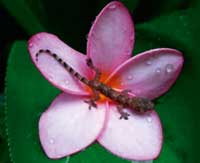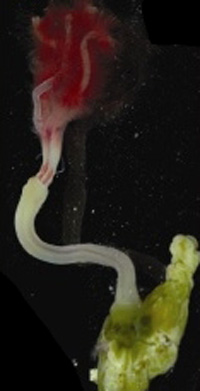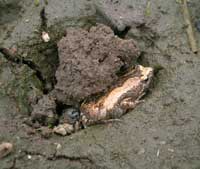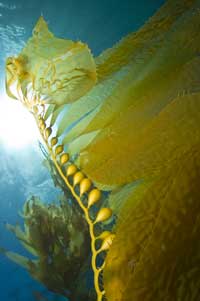Biodiversity: a look back at 2009 Understand article
In celebration of the International Year of Biodiversity 2010, Matt Kaplan takes us on a whirlwind tour through the previous year’s most inspiring discoveries of biodiversity.

The boundless variety of life on Earth never ceases to amaze. In spite of the fact that the world is smothered in humans, new details continue to arise that reveal life to be ever more diverse. Sometimes these new details reveal the presence of new species; sometimes they are behaviours or chemistries that indicate existing ecological relationships are more complex than anyone realised.
With regard to species discoveries, the past year has been no different from others in recent decades, and new species have turned up as a result of intensive exploration all around the globe. Some of the work has been rather old-fashioned, with researchers literally turning over rocks in the jungle. Other projects have taken on a decidedly more modern twist, with research teams using genetics to work out that what we thought was a single species is, in fact, two species.
Perhaps the most intriguing species find reported in the past year has been a bunch of worms that a team led by Robert Vrijenhoek at the Monterey Bay Aquarium discovered off the coast of California, USA.
Five years ago, the team found worms hanging around the bones of whales and other large mammals on the ocean floor. They realised that these worms were rooting themselves in, and absorbing nutrients from, the whale bones. They were, bizarrely, animals that had become specialists at feeding on bones on the ocean floor.
At first glance, Vrijenhoek and his team assumed that the worms on the bones were just one or two species all doing roughly the same thing, yet that number quickly expanded to five species in the years following the worm’s discovery, and in 2009, the number jumped to seventeen. This led the team to theorise that there might be more than one way for a worm to feed on a bone.

whale
Image courtesy of Robert C.
Vrijenhoek, Shannon B. Johnson
& Greg W. Rouse;
image source: Wikimedia
Commons
None of the worms have mouths or anuses. Instead, they all have a bulbous root system that they embed in the bones, and a variety of different feathery structures that the researchers think are being used for respiration (see image).
Exactly how the worms draw out nutrients from bones is still something of a mystery, but the large number of new worms found in 2009 have so many different forms and body structures that the researchers are beginning to suggest that the ocean floor has an entire ecosystem of bone feeders of different sizes and shapes which likely have different tactics for feeding on bones.
A species that is making this point most clearly is one of the newly discovered worms which, at first glance, seems to embed itself in sediment rather than bone. Yet as the research team went to look closer, they found that these worms, although anchoring in sediment, had very long root systems that ran out to buried bone fragments. They were effectively functioning as buried bone-shard feeding specialists, making them quite different from the other bone-feeding worms which have all been found directly embedding themselves in bones. The team expects that as they further study the new worms, even more diversity will be uncovered.
Further exploration of the worms and their behaviours is definitely needed, but for the moment, it looks as if there is an entire world of bone feeders in the ocean depths.
Discovering new species is not all there is to biodiversity. Discovering new ways in which already known species interact is equally important, and from this perspective, 2009 was one of the more fascinating years, as research has revealed that the presence or absence of elephant faeces plays an important role in biodiversity.

Savandurga, India. These
frogs are also found in
elephant dung
Image courtesy of L. Shyamal;
image source: Wikimedia
Commons
In Sri Lanka, Asian elephants are continually being pushed out of forests and isolated from regions where they are seen as troublemakers. To be fair, there is a lot of truth to this: the elephants readily destroy trees if left in an area for long enough. However, Ahimsa Campos-Arceiz at the University of Tokyo, Japan, revealed last year that the elephants appear to be giving back to their environment in a small but important way: their piles of faeces provide housing to numerous species, including three species of frogs.
The dung of many large mammals has long been known to be a fertile place for plants and fungi to grow, but seeing the dung itself used as a dwelling by amphibians… well, that’s rather new.
Aside from frogs, Campos-Arceiz reports in the journal Biotropica that he discovered beetles, termites, ants, spiders, scorpions, centipedes and crickets in many of the elephant dung piles, suggesting that an elephant dung pile can become a small ecosystem on its own. In contrast, when he examined large piles of dung from other animals, such as cows, similar levels of diversity were not found.
Campos-Arceiz proposes that the amphibians and insects might just be following the trails of dung and moving with elephant populations, suggesting that elephants literally bring their own biodiversity wherever they go.

iStockphoto
Just as new social interactions are constantly turning up amongst well-known species such as elephants and frogs, so too are new chemical interactions. By far the most interesting interaction identified in 2009 is that of seaweeds strategically mounting antimicrobial defences on their surfaces, in locations where they need extra protection against pathogens.
In the past decade, it has come to light that seaweed species have a host of antimicrobial chemical compounds inside them. These findings have led to considerable interest in seaweeds as potential sources to be bioprospected for the development of antibiotics.
While further exploring the seaweed family and their chemical compounds, a team of researchers led by Julia Kubanek at the Georgia Institute of Technology in Atlanta, USA, discovered that the antimicrobial chemicals were not distributed throughout the seaweeds evenly. Instead, they were spread out in patches along the seaweed surface. These patches were also covered with sediment and particles that had been floating about in the water.
Kubanek and her colleagues reported in The Proceedings of the National Academy of Sciences USA last year that they believe the seaweed is creating its own version of a scab. As the seaweed gets cut, attacked or abraded, they believe it oozes sticky carbohydrates rich in antimicrobial chemicals from inside. These chemicals then prevent the seaweed from becoming infected and the sticky ooze collects floating particles from the water to cover up the injured area. This sort of behaviour has never been seen before in seaweed, but the authors suggests that it may be similar in function to the resin that pine trees ooze when cut.
Practically, the find is important for developing pharmaceuticals that can help wounds heal, but from a grander ecological perspective it is no more or less important than the discovery of new bone-feeding worms or of the use of elephant faeces as accommodation. Indeed, just when it seems as if the world’s biodiversity could not possibly become any richer, researchers prove that it can.
Acknowledgements
The author would like to thank Drs Vrijenhoek, Campos-Arceiz and Kubanek for taking the time to proofread this work and for providing valuable feedback.
Resources
- To read more about the discoveries described in this article, read the published research:
- Campos-Arceiz A (2009) Shit happens (to be useful)! Use of elephant dung as habitat by amphibians. Biotropica 41: 406-407. doi: 10.1111/j.1744-7429.2009.00525.x
- Lane AL et al. (2009) Desorption electrospray ionization mass spectrometry reveals surface-mediated antifungal chemical defense of a tropical seaweed. Proceedings of the National Academy of Sciences 106: 7314-7319. doi: 10.1073/pnas.0812020106
- Vrijenhoek RC, Johnson SB, Rouse GW (2009) A remarkable diversity of bone-eating worms (Osedax; Siboglinidae; Annelida). BMC Biology 7: 1-13. doi: 10.1186/1741-7007-7-74
- BMC Biology is an open-access journal, thus all articles are freely available online.
- For more information on the International Year of Biodiversity, see: www.cbd.int
- The website includes a manual for educators, Biodiversity is Life: www.cbd.int/iyb/doc/partners/iyb-waza-manual-en.pdf
Review
This article is very pleasant to read and will probably give a whole new meaning to the term ‘biodiversity’ to most readers. The scope is to show that biodiversity is by far richer than we can possibly imagine; to prove this, the author provides examples that will surprise and even amuse the reader.
The article could be useful in the study of ecology and specifically in the examination of the behaviour of and the relationships between different species of organisms, as it suggests ‘unconventional’ ways in which organisms interact with each other and with the environment.
The article could be used to discuss biodiversity and particularly the various forms it can take. Comprehension questions could include:
- Biodiversity is a complex term. Explain three forms that biodiversity can take, giving one example for each.
- In the article, there is a claim that elephant dung could become a small ecosystem. Do you agree or disagree with this claim? Explain the reasons for your decision.
- Describe a specific behaviour adopted by certain species of seaweed that helps them defend against pathogens when they are damaged.
Michalis Hadjimarcou, Cyprus





